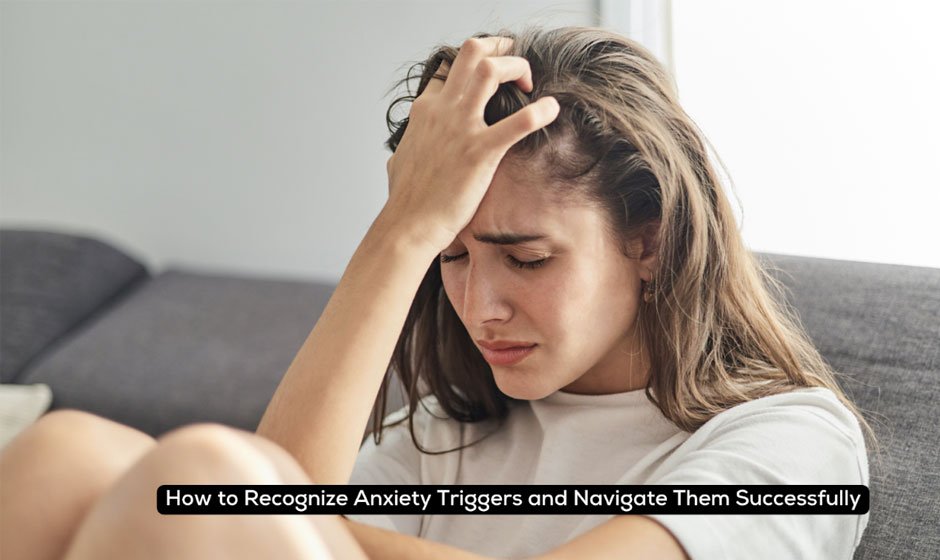Feelings of anxiety are an innate and universal human experience. In moderation, anxiety can even be helpful, priming us to handle potential threats or challenges. However, for many people, anxiety manifests in excessive, disproportionate ways that disrupt day-to-day functioning and overall well-being.
Recent statistics indicate that over 19.1% of the population is affected by anxiety disorders each year. For this population, anxiety is no longer an occasional, expected reaction but rather a debilitating force that hijacks their life.
Although genetics and brain chemistry contribute, external triggers in an individual’s environment and experiences can significantly worsen clinical anxiety. These triggers provoke immediate, involuntary surges of irrational fear, panic, obsession, and unease. Learning to identify personal anxiety triggers and defuse their power is the foundation for gaining control over anxiety and restoring balance.
This comprehensive guide provides insights and strategies to recognize your unique anxiety triggers and successfully navigate through them on the path toward recovery and long-term resilience.
Understanding the Basis of Anxiety Triggers
Before diving into management techniques, it’s essential to understand what exactly triggers anxiety and why they hold such power over our emotions and behavior.
What Are Anxiety Triggers?
Anxiety triggers are situations, places, activities, thoughts, or objects that instantaneously induce intense anxiety, fear, panic, or obsessive thinking. Triggers often provoke a rush of stress hormones like cortisol and adrenaline, activating the body’s innate “fight-or-flight” reaction.
Triggers are highly specific to each individual and their experiences. For some, crowded places trigger claustrophobic anxiety while for others, being alone causes panic. Public speaking may induce anxiety in certain people while driving or heights represent the trigger for others. Even enjoyable events like vacations can transform into triggers if connected to past trauma.
Triggers can tap directly into the brain’s fear center, known as the amygdala. This almond-shaped region processes perceived threats and controls emotional reactions like anxiety and fear. Triggers stimulate the amygdala, setting off an immediate anxiety response before logic can intervene.
How Triggers Impact Mental and Physical States
When a trigger activates the amygdala, it sets off a chain reaction of psychological and physiological changes:
- Increased heart rate, blood pressure, sweating: The amygdala signals the sympathetic nervous system to go into “fight or flight” mode, flooding the body with stress hormones.
- Rapid, shallow breathing: Hyperventilation occurs due to panic.
- Muscle tension: An anxiety trigger instantly makes muscles tense up.
- Dizziness, fatigue: Anxious arousal diverts oxygen and energy from bodily systems, leading to lightheadedness and tiredness.
Along with physical reactions, triggers can also generate spiraling negative thoughts, fears of impending doom, sensations of unreality, obsessive thinking, or compulsive behaviors. This mutually reinforcing cycle of mental and physical anxiety responses quickly becomes overwhelming.
Examples of Common Anxiety Triggers
Some of the most prevalent triggers include:
- Occupational or financial stress
- Interpersonal conflicts
- Social situations like parties or public speaking
- Health-related fears like illness or doctor visits
- Phobias such as heights, insects, or needles
- Traumatic memories and past experiences
- Environmental factors like crowds, enclosed spaces, or loud noises
However, even joyful events like vacations, weddings, or job promotions can transform into anxiety triggers if linked to past trauma, loss, or abandonment. The context shapes whether a situation becomes a trigger. For those in substance abuse recovery, resources for maintaining sobriety can lead them to better recovery methods. The loss of control and trauma associated with relapse could create situational triggers around substances, social settings, and emotions linked to past use.
Since triggers are rooted in our memories and experiences, they are highly specific to each person. We all perceive the world through our unique lenses. The process of unraveling those personal triggers from general stressors is essential for anxiety management.
Helpful Methods to Manage Reactions to Anxiety Triggers
Once aware of your triggers, evidence-based strategies can help master your reactions, rather than being mastered by them. Tailor these techniques into a personalized “anxiety toolkit”:
Cognitive-Behavioral Therapy (CBT)
This proven method aims to defuse anxiety by identifying and modifying dysfunctional thought patterns. As explained in The Cognitive Behavioral Workbook for Anxiety, CBT practitioners teach patients to:
- Recognize automatic negative thoughts and cognitive distortions, like overgeneralizing or catastrophic thinking.
- Counteract exaggerated anxious thoughts with more realistic, balanced perspectives.
- Replace alarmist “what-if” thinking with positive self-talk and affirmations.
By reshaping thought processes, CBT reduces the tendency to spiral into anxiety. Developing awareness around these mental habits via CBT techniques can be highly effective for long-term change.
Mindfulness-Based Stress Reduction
Mindfulness teaches present-moment focus and non-judgmental awareness. Research covered in Harvard Health Publishing reveals that practices like mindfulness meditation, breathing exercises, and grounding techniques reduce anxiety by quieting the mind’s fixation on triggers.
Rather than being immersed in worrying thoughts about the past or future, mindfulness anchors you firmly in the now. Try evidence-based apps like Calm for guided mindfulness sessions.
Relaxation Strategies
Tactics that calm the body reduce anxiety’s physical symptoms. Methods like diaphragmatic breathing, progressive muscle relaxation, meditation, visualization, and yoga inhibit the fight-or-flight response, according to anxiety specialists at the University of Michigan.
For example, breathe slowly from the abdomen rather than shallow chest breathing. Or mentally picture your anxiety flowing out of your body. Reducing muscle tension and quieting mental chatter in this way diminishes anxiety.
Healthy Lifestyle Choices
Around 20-30 minutes of aerobic exercise most days, along with a nutritious whole foods diet and adequate sleep, fortifies mental resilience against triggers. When our basic physical needs are met, we are better equipped to cope with anxiety triggers.
Social Support
Don’t underestimate the power of feeling connected, understood, and cared for. Anxiety Canada finds that spending time with supportive communities provides a sense of belonging that intrinsically reduces anxiety. Share your experiences with patient confidants. Keep communication open with family about your needs.
Professional Mental Health Support
For some, anxiety triggers may require medications or therapy. Seeking help strengthens long-term management. Work with a practitioner to determine what professional treatment suits your needs.
Experiment to find the right “recipe” of techniques that empower you to navigate through each trigger. Consistency is key, but stay flexible, reevaluating and adjusting your toolkit over time as needed.
Strategies to Identify Your Specific Anxiety Triggers
Becoming aware of your distinct anxiety triggers is the critical first step. Here are proven techniques to unravel those triggers from background stressors through self-inquiry, observation, and external input:
Journaling
Keeping an ongoing journal helps reveal patterns by logging anxious episodes, emotional states, and thought processes over time. The ADAA recommends tracking details like:
- What was happening right before you felt anxious?
- Where were you? Who else was there?
- How intense was the anxiety on a 1-10 scale? How long did it last?
- What physical sensations did you experience?
- What thoughts were going through your mind?
- Did you have any urges to act in certain ways?
Review your journal to uncover trends, associations, and recurring triggers. For example, you may notice spikes of anxiety every year around the anniversary of a divorce, when visiting a parent’s home, or when facing work deadlines.
Discussions with Close Friends and Family
People close to you may be able to point out anxiety triggers that manifest outwardly, but which you overlook internally. Confide with trusted friends or family about your anxiety struggles. Ask if they notice any particular situations where your anxiety consistently intensifies.
Your loved ones see you from a more objective vantage point than your own biased self-perception. Their caring input can help reveal blind spots and provide validation.
Assessments from a Mental Health Professional
For deeper insight, consult a psychologist or psychiatrist. They can administer diagnostic questionnaires and surveys to probe for hidden triggers. For example, the Anxiety Sensitivity Index assesses beliefs about anxiety, while the Adult Manifest Anxiety Scale evaluates how anxiety manifests in thoughts, personality, and behavior.
Combining their expert training with testing assessments provides an invaluable outside perspective. Therapy also offers a safe space to open up about inner struggles you may not share with others.
Be Patient and Non-Judgmental
Identifying triggers requires self-awareness, courage, and patience. Silently observe all thoughts, emotions, and sensations without judging them as “right” or “wrong”. Like a scientist calmly collecting data points, maintaining openness and detachment. Over time, repeated observation and journaling illuminate those triggers.
Proactive Strategies to Build Long-Term Resilience
Managing acute anxiety when triggers arise is crucial. However, proactively building resilience against future triggers is equally important.
Exposure Therapy
This go-to method involves gradual, controlled exposure to anxiety-provoking situations to systematically desensitize yourself. By facing fears little by little in a therapeutic setting, triggers begin to lose their power.
Start minimally – for example, just look at photos of spiders if those are your phobia. Over multiple sessions, gradually work up to facing the actual feared object or situation under a therapist’s guidance. With patience, triggers no longer provoke the same visceral panic.
Stress Inoculation Training
This method outlined in The Clinical Handbook of Fear and Anxiety involves three phases:
- Education – Learn about the psychology of anxiety, common triggers, and management methods. Knowledge is power.
- Skill acquisition – Practice coping techniques like assertiveness and relaxation until they become second nature.
- Application – Use your skills to handle real-life anxiety situations and build confidence.
Stress inoculation “vaccinates” you by gradually exposing you to manageable levels of anxiety to boost your coping muscles.
Maintaining Healthy Habits
Ensure good sleep hygiene, regular exercise, healthy nutrition, and stress management as daily habits, not just crisis interventions. According to research published in Frontiers in Psychiatry, lifestyle factors profoundly influence resilience against triggers in the long run.
Regular Check-Ins with Your Support Network
Periodically connect with your social support network, counselor or therapy groups about your progress. Anxiety management is a marathon, not a sprint. Accountability and encouragement from people invested in your growth help you go the distance.
Don’t wait until crisis moments to seek support. Instead, maintain open communication on an ongoing basis to proactively strengthen your mental health over months and years.
Helpful Digital Tools and Resources
Along with established strategies, cutting-edge technology offers convenient resources to help individuals actively manage anxiety:
Mental Health Apps
Applications like MindShift CBT, Anxiety Coach, and Calm provide tools to track anxiety, set goals, access coping methods, and reinforce learning between therapy sessions. Wearable devices can also monitor heart rate and stress biomarkers.
For example, Breathwork guided meditative breathing exercises to reduce anxiety, while Moodpath enables users to log emotions and uncover triggers. Leverage these digital solutions to supplement traditional techniques.
Online Forums
Platforms like the ADAA website or Anxiety Canada’s online community forums connect people facing similar mental health conditions. Communicating with groups who understand the daily fight against anxiety helps alleviate feelings of isolation.
Podcasts and Webinars
An array of podcasts like The Anxiety Coaches Podcast explore strategies to understand triggers and retrain thinking. Webinars similarly enable therapists and authors to share their expertise digitally with broad audiences needing support. Make use of these on-demand resources.
Virtual Reality (VR)
Cutting-edge VR-based mobile apps like MindCotine use immersive simulated exposure therapy to conquer triggers associated with addictions and phobias. Further innovations applying VR, augmented reality, and wearable biofeedback for anxiety management are on the horizon.
Coping Flexibly with Unexpected Triggers
Despite your best efforts, unexpected triggers still occur. The key is handling unplanned triggers with composure and adaptability:
- Pause and take 10 deep, mindful breaths to activate the parasympathetic nervous system, reducing the stress response.
- Quickly scan your “anxiety toolkit” and implement one of your practiced coping exercises like a grounding technique or relaxing visualization. Having these tools memorized helps rapidly re-stabilize.
- Avoid excessive self-judgment. Be compassionate with yourself, remembering unexpected triggers is part of recovery. Don’t let a stumble derail your progress.
- Once calm, reflect on what worked well at the moment and what could be improved to inform your future responses. This flexible, growth-oriented mindset keeps you progressing.
With consistent practice, these skills to navigate unanticipated triggers in real time become second nature. Be patient – it takes time to overcome conditioned responses. Progress may be non-linear, but perseverance pays off.
FAQs
What’s the difference between a trigger and general stress?
Triggers evoke immediate, disproportionate anxiety without conscious thought whereas everyday stressors provoke anxiety to expected degrees based on context. The response to triggers tends to be involuntary and rooted in past experiences compared to common worries.
Can triggers change over time?
Absolutely. Triggers often evolve across our lifespan as we encounter new experiences and alter old associations. It’s critical to periodically re-evaluate your triggers and update your management strategies accordingly. Ongoing self-awareness helps ensure you’re addressing current challenges.
Why do past traumatic events still trigger me even years later?
Our brains are wired to remember threatening situations to protect us in the future. But this survival mechanism can backfire, causing old memories to trigger anxiety despite time passing. Techniques like EMDR (Eye Movement Desensitization and Reprocessing) can help reprocess traumatic memories. Continued exposure therapy also helps reduce their power.
How can I explain my triggers to friends and family without feeling embarrassed or misunderstood?
Use clear “I statements” focused on your emotional experience rather than passively saying anxiety “makes me” react. For example, say “I tend to feel very anxious in crowds.” Specify what helps, like having someone with you or sitting near the exit. Most loved ones will respond with empathy if you openly communicate your perspective and needs.
Are anxiety triggers mainly psychological or biological?
Both factors are at play. Triggers activate biological stress systems like the amygdala and sympathetic nervous system while also triggering cognitive-emotional processes based on past experiences and associations. Our perceptions and life history shape triggers, which in turn have physical effects.
Will I always have to live with anxiety triggers?
With dedicated treatment and conscious reconditioning of thought patterns, many triggers can lose their power over time. However, we all have unique propensities shaped by our genes and life experiences. Managing triggers is an ongoing process of self-discovery and growth. With work, triggers can be minimized but may not disappear entirely.
Why do some people have more anxiety triggers than others?
A mix of genetic makeup, adverse childhood experiences, trauma history, learned thought patterns, overall stress levels and personality traits like neuroticism contribute to how easily triggers provoke anxiety. Those with more chronic stress or a history of trauma tend to have more triggers compared to relaxed personalities.
Are there ways friends and family can help avoid my anxiety triggers?
Yes. Educate loved ones on situations that tend to trigger your anxiety, like crowded parties or driving in the car. Develop signals to communicate your distress if a trigger arises unexpectedly so they can help you exit. Also share specific ways they can support you, like sitting near exits or distracting you during procedures.
What professional help is recommended for chronic anxiety triggers?
Cognitive behavioral therapy is considered the most effective, often combined with exposure therapy. Anti-anxiety medications like SSRIs may be prescribed in some cases if triggers remain severe. Psychiatrists or clinical social workers can devise an integrated treatment plan tailored to your needs. Seeking help is a strength.
Are there any unusual or surprising anxiety triggers I should watch for?
Absolutely. For example, a drop in estrogen during menopause or PMS can trigger anxiety in women. Caffeine and electronic use before bedtime are other underrated triggers. Track even subtle lifestyle factors. Triggers can manifest in unexpected ways that require some trial and error to identify. Stay observant.
In Conclusion: Your Journey to Understanding and Mastering Your Triggers
We all face anxiety and stress in life. Yet with knowledge of your personal triggers, a diverse toolkit of coping techniques tailored to you, and a commitment to ongoing recovery, anxiety can be managed successfully.
Learning to approach triggers without fear prevents anxiety from limiting your life. Experiments show it takes an average of 66 days to rewire thinking and behavior. With concerted effort and courage, lifelong patterns can transform.
This is a profound journey of self-discovery and growth. By shedding light on those anxiety triggers lurking in your subconscious, they lose their control over you. Transformation requires patience with yourself and faith in the larger process. Each step forward builds your resilience and brings you closer to lasting well-being.






